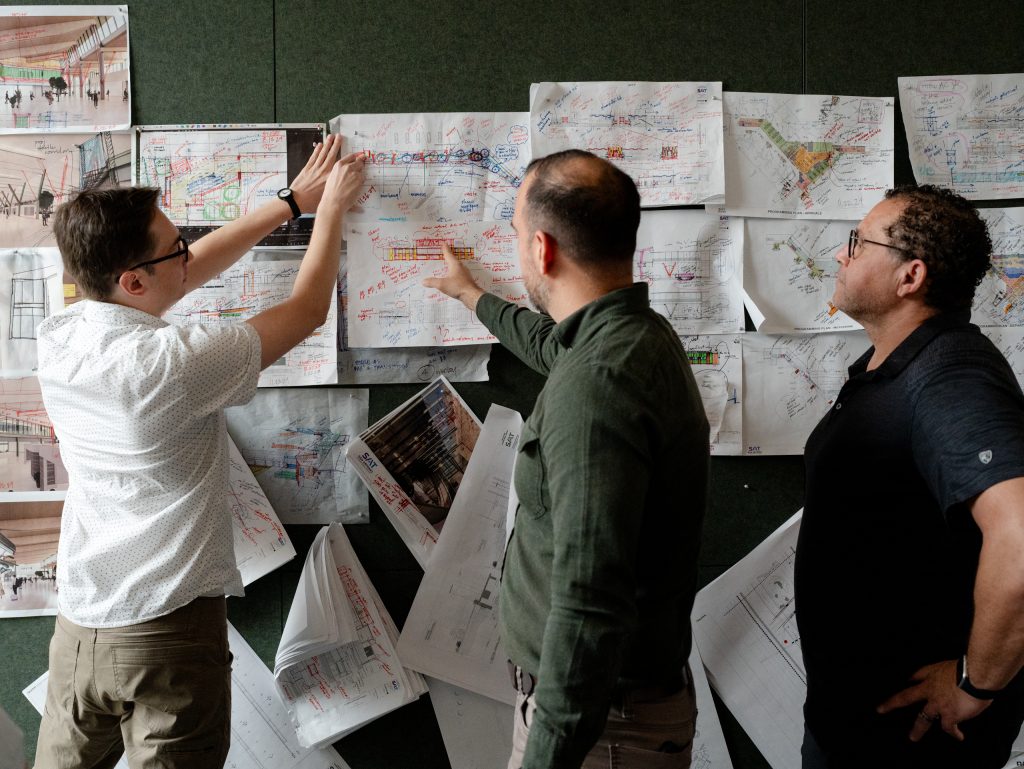More than a year has passed since San Antonio got a preview of a planned new airport terminal and two months since officials broke ground.
Now those early design concepts have been set in motion as the two architecture firms hired by the city in 2022, through a $3.8 million contract, work toward the expected 2028 completion date of a new terminal for the San Antonio International Airport (SAT).
Dallas-based Corgan, a firm with offices in San Antonio and 18 cities around the world, is teamed up with the nationally recognized firm Lake Flato to design a modern $1 billion concourse.
At $1.68 billion, the airport’s expansion is the largest capital project in the city’s history.
City officials broke ground on the project in early December and site work began the following day.
While the design development documents are due in February in keeping with the construction timeline, the architects are in it for the long haul, working hand-in-hand with the general contractor, Hensel Phelps, until it opens three years from now.
From an office building just outside the airport gates, both firms are huddling with airport officials over the drawings and specifications required to build a terminal that will expand the airport by 17 gates.

Among the occupants in the Airport Center office space are the planning engineers and Deputy Aviation Director Tim O’Krongley.
O’Krongley has a long history with building airports. He was on the team that built the Austin-Bergstrom International Airport in the 1990s, the Boeing facility at Port SA and Terminal B at the San Antonio airport.
He said the new SAT terminal is the best project he’s worked on and different from the others in that the city has employed a construction manager at risk method to build the terminal, a program that brings the contractor in early on a project.
Corgan has had offices in San Antonio for over 25 years, and will soon move into the 19th floor of Frost Tower. The firm also works in education, architecture, data centers and interior workplace design, and its San Antonio clients have included area school districts, CyrusOne and CPS Energy.
But it also has a long history with aviation projects — going back 70 years and resulting in a large portfolio of work, said John Trupiano, principal at Corgan.
The more than 200 airports Corgan has had a hand in include the Dallas Fort Worth and Los Angeles (LAX) international airports, LaGuardia and John F. Kennedy airports in New York, and Shanghai Pudong in China.
“Pretty much if you’ve flown there, there’s a good chance that we have done work there,” Trupiano said.

While SAT, with its roughly 11 million passengers a year, is no LAX, Trupiano said his firm is looking to deliver the kind of experience travelers expect in a major airport, “but do it in a growing and vibrant community.”
Trupiano has spent his entire architecture career, more than two decades, working on aviation projects. That despite never having flown on an airplane until the day in 1998 when Corgan flew him from Kansas City to Dallas for a job interview.
“That one experience really just solidified that this is where I wanted to be,” he said. “From that day onwards … it just kept feeding on that passion. Now I do projects all across the globe.”
As principal in charge of the SAT terminal project, Trupiano leads the design team made up of 25 different consultant firms and the Lake Flato architects.
The team works together on all components of the design, with each firm offering distinct expertise, he said.
For Lake Flato, that means especially the “place-making,” a term for designing a place that’s comfortable and feels familiar.
“There’s the functionality of the airport and the complexity of what it takes — fueling loops and baggage systems and all of those things,” said Joseph Benjamin, lead partner on the project for Lake Flato. “But ultimately … it’s a building for people, and how do you create great spaces … that people want to be in?”

Benjamin works on civic projects and Lake Flato designed a small airport in Florida years ago. That relative newness to aviation design also gives them the liberty to challenge convention.
“Sometimes it’s because there’s a long list of reasons why they do it that way and then other times it’s like, ‘I don’t know, we’ve always done it that way, but let’s look into why,’” he said.
Terminal A was completed in 1984 and has 17 gates. It is considered problematic due to its narrow layout, limited gate availability, insufficient baggage system and cramped security checkpoint.
Even with millions of dollars in renovations promised by SAT officials, Southwest Airlines sued the City of San Antonio when the carrier was assigned to the terminal in a new agreement last year.
SAT’s Terminal B opened in 2010 with eight gates. It was designed by Corgan and 3D/International of Houston. In 2023, two additional gates were added. The new terminal will be merged with Terminal B.
The two terminals are anything but cohesive and the architects are not looking to either of the terminals for inspiration, Trupiano said.
“We really went a different direction with the new terminal, and that is a very strong focus on the regionalism and the San Antonio sense of place,” he said.
“We sometimes get caught up in thinking that this terminal just serves San Antonio when it really has a much larger catchment area and provides competition as you go north.”
It’s important to capture that geographic diversity in the design, he said.
Travelers will enter the terminal through a paseo, a 60-foot offset between the departure and arrival lanes and the building facade. The landscaped outdoor space is meant to reflect San Antonio’s waterways such as the River Walk.

Entering the building, a traveler will see limestone and wood used and muted earth tones.
“The color palettes and materials in there all draw on some of the neutral colors that we pick up from the Hill Country landscapes,” Trupiano said. “We bring in some of the colors of the creeks and the streams, but then those will get punctuated by those more vibrant colors that make up the kind of that cultural fabric of San Antonio.”
Once past the security screening checkpoint, the vibe changes to what the architects are calling a Mercado or concession plaza. The terminal will open to an outdoor terrace flanked on either side by concessions.
There was a time when airlines built airport terminals, Trupiano said, and Corgan became very familiar with what a carrier needed in an airport.
After 9/11, that work shifted to municipalities and airports.
“And the needs and the wants changed to being focused on passenger experience, passenger amenities and competition between cities of … what makes this a choice destination,” he said.








